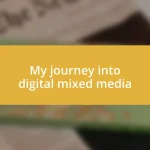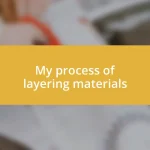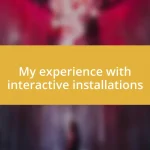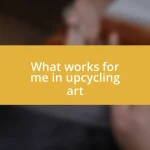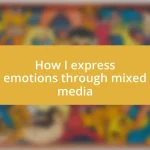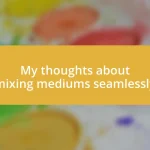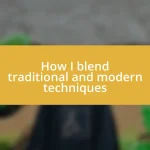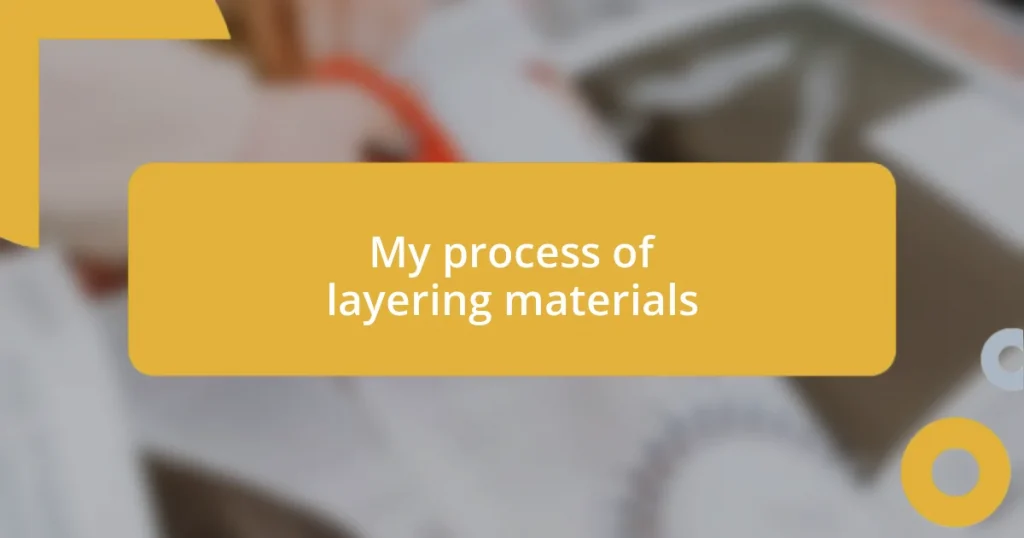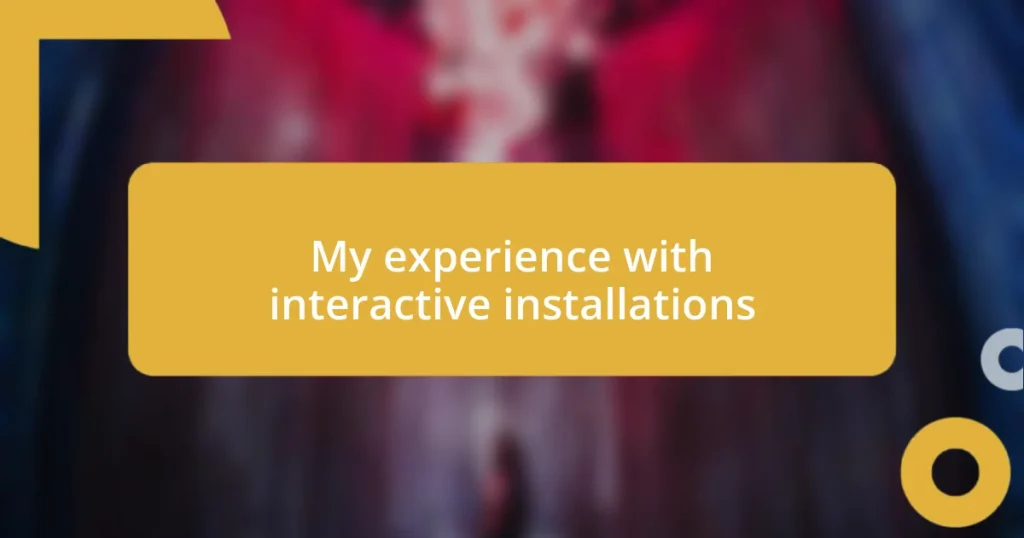Key takeaways:
- 3D mixed media art combines various materials and techniques, allowing for richer storytelling and emotional connections through layered textures and dimensions.
- Key techniques include layering, assemblage, texturization, and resin application, each offering unique ways to enhance the visual depth and tactile experience of the artwork.
- Engagement with tools, collaboration with other artists, and utilizing resources such as online courses and communities can significantly enhance creativity and artistic development in mixed media projects.

Introduction to 3D mixed media
3D mixed media is such an exciting realm of art that marries traditional techniques with new, innovative materials. I remember the first time I stumbled upon a beautiful sculpture made of found objects and clay. It sparked a realization for me: art can be anything, and why limit ourselves to just one medium?
As I delved deeper into this fascinating field, I found that combining 3D elements with other materials like paint, fabric, or even digital components opens up endless creative possibilities. Isn’t it intriguing how layering textures and dimensions can evoke emotions that a flat canvas might not? I often feel a rush of excitement when I brainstorm ideas that blend various media, transforming my artistic vision into something tangible.
What truly draws me into the world of 3D mixed media is the chance to tell a story through diverse materials. Each piece, whether it’s a quirky assemblage or a refined installation, has its own narrative. Have you ever found yourself captivated by an artwork that made you feel a connection to its creation? That experience is what motivates me to explore and push the boundaries of creativity in 3D mixed media.

Understanding mixed media techniques
Understanding mixed media techniques allows you to explore the synergy of different materials. For instance, when I experimented with adding resin to my paintwork, I was astonished by the glossy finish it created – almost like a window into the artwork. This technique not only enhanced the visual appeal but also added a layer of depth, making the piece more immersive.
Throughout my journey, I’ve tried incorporating fabric into my sculptures. The soft textures contrasted beautifully with hard materials like metal and wood, creating a dynamic that invited viewers to interact with the work. It’s fascinating how these independent elements communicate with one another, transforming the initial vision as the piece evolves during the creative process.
Engaging with mixed media isn’t just about combining materials; it’s a dialogue between the artist and the artwork. Each technique brings its own rhythm, like a conversation, where one material’s voice can highlight or soften another’s. Reflecting on my own practices, I find that the moments of experimentation often yield the most rewarding results, inviting serendipity into my creative flow.
| Technique | Description |
|---|---|
| Layering | Combining paints, textures, and different media to create depth. |
| Assemblage | Creating art from found objects or materials, giving new life to discarded items. |
| Texturization | Incorporating rough or soft elements to enhance tactile experiences in art. |
| Resin Application | Using resin to add gloss and depth, transforming two-dimensional works. |

Tools for 3D mixed media
When diving into 3D mixed media, the right tools can make an incredible difference in how your artistic vision comes to life. One of my favorite discoveries has been the world of sculpting tools—there’s something meditative about shaping materials with my hands. During a recent project, I picked up a set of clay modeling tools that not only helped refine intricate details but also transformed my approach entirely. The sheer joy of watching a shapeless lump of clay morph into a vivid expression of my idea is an experience I cherish.
- Sculpting Tools: Essential for shaping and refining materials like clay and wax.
- Adhesives: Different types, such as hot glue or industrial-strength glue, are crucial for securing various elements.
- Paints and Dyes: Acrylics, tempera, and fabric dyes allow for adding vibrant colors to your creations.
- Cutting Tools: Craft knives and scissors are indispensable for precise cuts in materials like paper, fabric, and cardboard.
- Mixed Media Mediums: Grunge paste, gel mediums, and varnishes open up fresh ways to manipulate texture and finish.
As I explored various adhesives, I found that each type brings its own character to a piece, influencing both the aesthetic and structural integrity. I recall a moment when I accidentally used a fast-setting epoxy on a delicate paper sculpture. The way it bonded the seams created an unexpected strength that, while initially unsettling, turned into a surprising element of resilience in my work. Each experience teaches me to embrace the unpredictability of the medium, guiding my creative journey in new, exciting directions.

Step by step project guide
Creating a 3D mixed media piece can seem daunting at first, but breaking it down into manageable steps makes the process much more enjoyable. I remember when I started my first project; I outlined everything from concept to execution on paper. This simple act helped me visualize the entire journey and kept me focused, ensuring I didn’t get lost in the layers of creativity. Have you ever felt overwhelmed by the choices? Trust me, it’s completely natural—taking it one step at a time can lead to some delightful surprises.
The next crucial step is gathering your materials. I’ve found that embracing the unexpected can yield the most inspiring results. For instance, when I once scavenged materials from my local thrift store, I uncovered a treasure trove of textures—an old wooden frame, some lace, and a collection of vibrant buttons. Each piece sparked new ideas, challenging me to think outside the box. Isn’t it fascinating how a simple visit to a second-hand shop can completely shift your project direction?
Once you start assembling your art, remember to play! I’ll never forget the day I unintentionally layered paint on top of wet glue—what could have been a mistake transformed into a breathtaking texture that I never would have created otherwise. Allowing the materials to interact organically often results in serendipitous moments that breathe life into your artwork. So, as you embark on your own projects, keep that spirit of exploration alive—who knows what magic awaits?

Tips for enhancing creativity
To enhance creativity, I believe it’s essential to step outside your comfort zone. I’ve often found that trying an unfamiliar medium can ignite a fresh wave of inspiration. For example, when I experimented with incorporating fabric into my mixed media projects, I discovered new textures and colors that transformed my work in ways I hadn’t anticipated. Have you ever had a similar experience? That moment of surprise can be incredibly rewarding, pushing you to explore avenues you never considered.
Another valuable tip is to maintain a creative journal. I started keeping one to jot down thoughts, doodles, and random ideas, and it has proven to be an invaluable resource. Each entry is like a snapshot of my creative journey, and on days when inspiration is lacking, flipping through those pages sparks new ideas. It’s amazing how a simple note—a fleeting thought about color or texture—can evolve into a full-blown project. Don’t you think it’s fascinating how our minds work that way?
Don’t forget the importance of collaboration. I’ve collaborated with fellow artists, and each partnership has opened my eyes to different perspectives and techniques. I vividly remember a project where I teamed up with a friend who specialized in photography. Her insights on visual storytelling enriched my understanding of composition in 3D mixed media. Each interaction is an opportunity to learn and grow. So, why not reach out to someone you admire? You might uncover creative possibilities you’ve never imagined.

Showcasing your 3D art
Displaying your 3D art effectively can be a game changer in how it’s perceived. When I first exhibited my work, I was surprised by how much the presentation influenced viewers’ reactions. I decided to create a dedicated space where the pieces could relate to each other while also standing out individually. Have you considered how different lighting can alter the mood of your artwork? I learned that using spotlights in a darkened room creates drama, drawing people closer to inspect the details.
Think about the storytelling aspect of showcasing your art. I once created a small display that featured my work alongside notes about my thought process. Each piece had a little card that described what inspired it, which sparked engaging conversations. It’s incredible how people connect when they understand the emotions behind the art. Don’t you find that sharing your journey can make your creations even more compelling?
Remember, the environment matters too! I’ve exhibited in both informal settings like local coffee shops and formal galleries, and each venue provided a unique interaction with my audience. I particularly cherish a moment at a gallery opening where friends and strangers gathered around my work, sharing laughter and stories inspired by what they saw. It reaffirmed for me that art isn’t just about the object; it’s about connection. What settings have you found amplify your creative expression best?

Resources for further learning
Finding resources to deepen your understanding of 3D mixed media can be truly enriching. I often turn to platforms like Skillshare and Udemy, where there are courses that dive into various techniques and mediums. Recently, I enrolled in a class focused on digital sculpting, which opened my eyes to how technology can complement traditional methods. Have you ever thought about merging digital and physical art? The possibilities are endlessly fascinating!
Books are another fantastic resource. One of my favorites is “Mixed Media: New Approaches to Collage” by Kate McGowan. It’s packed with insights and projects that pushed me to think outside conventional boundaries. I remember one project where I combined found objects with paint, and it led to a breakthrough moment in my work. Why not pick a book that challenges your creative limitations? You might be surprised by what you learn.
Don’t overlook online communities and forums. Platforms like Reddit and Facebook host vibrant art groups where members share tips, critiques, and inspiration. I remember joining a mixed media group. The feedback I received on one of my pieces was invaluable and helped me refine my technique. Have you ever found a supportive community that makes a difference in your artistic journey? Connecting with like-minded individuals can foster growth in ways you might never expect.
